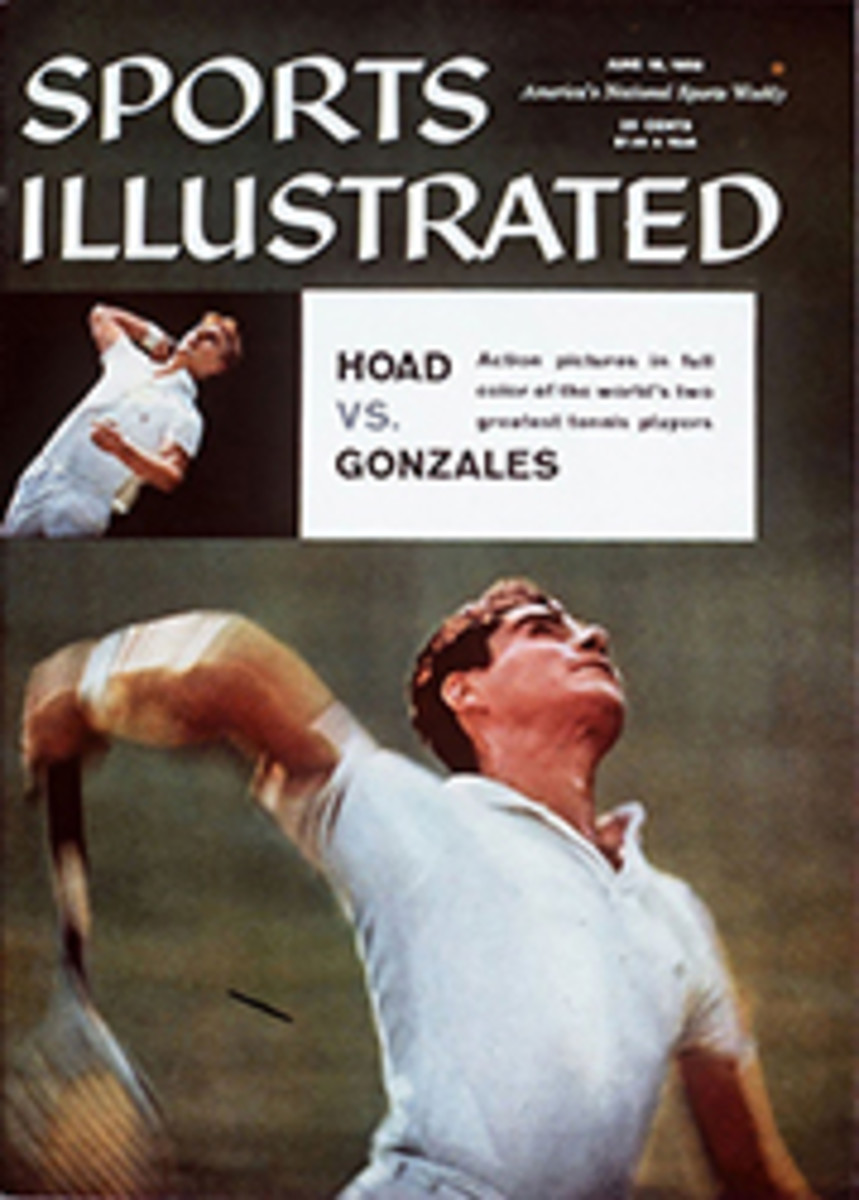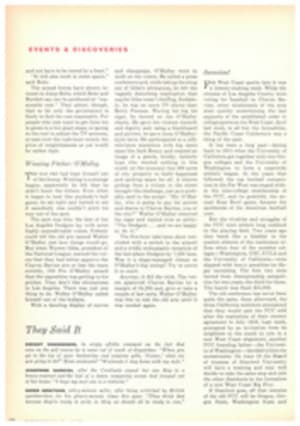
The great equalizer
The Bermuda Race, which starts June 14 off Newport, R.I., is considered the toughest all-round test in the world for ocean-racing yachts and yachtsmen. Between the start at Brenton Reef and the finish off St. David's Head, there are 635 miles of ocean filled with headwinds, flat calms, sudden squalls and the constantly changing currents of the Gulf Stream. The competing boats—120 entries in this year's record fleet-are the best in the world; and so are the men who sail them.
But the reason this race is so good is not only the course the boats sail or the quality of the fleet. It is, rather, the remarkable little rule book shown in the middle of this page, the Cruising Club of America Measurement Rule, which, through a labyrinthian handicapping formula, equalizes all competing boats just as surely as the Colt revolver equalized all men. In fact, without the Cruising Club Rule, known more simply as "The Rule" to thousands of yachtsmen who live under its austere domination, the Bermuda Race would not be a race at all. Neither would most American distance races, since they are now handicapped by the Rule or a derivative of it.
There is an axiom in sailing which says that the speed of an ocean-going yacht can be no more than 1.3—or at most 1.4—times the square root of its waterline length. Boiling this down to a dangerously simple generality, big boats will beat little boats. Besides size, there are literally hundreds of other factors that control speed. Given two boats the same size, the thin one usually beats the fat one. The tall mast beats the short mast. The deep, heavy keel beats the shallow keel. And so on. Therefore, without some sort of handicapping, boats like Irving Pratt's 57-foot sloop Caper (opposite) would simply clobber boats like Carleton Mitchell's 38½-foot Finisterre. The final standings of every race would look like an Army platoon, with the tall rangy men up front and the short fat men straggling along in the rear; and the race would die.
It did die once, after the 1910 race, just because there was no fair kind of handicap. It stayed dead until 1923, when the bare bones of the present Rule, based mostly on waterline length, were laid down. But water-line length was obviously not enough. A rule which would encompass all the subtle factors affecting speed was needed, and through the heroic calculations of a genius named Wells A. Lippincott it was supplied. Since 1934 the Rule in its present massive form has stood sternly astride sport of ocean racing.
The Rule is a miracle of compromise and foresight—27 pages of measurements, formulas, fractions and whereases that rate the speed-giving potential of almost every screw and splinter on a boat. As soon as the owner of a new boat decides he wants to enter the Bermuda, or any other race held under the Rule, he has to get his boat measured for a rating which henceforth and forever fixes his racing relationship with other boats unless he changes his boat or protests his rating. Many yacht clubs have an official measurer, but for big races like the Bermuda a good percentage of the calculations are made by specialists like the Cruising Club's own measurer, Bob Blumenstock of Scarsdale, N.Y., who started in business as a naval architect but now spends half his life being harried and pursued by racing yachtsmen who want a new measurement.
"There's not a one of them," said Blumenstock one weary night last week as he plowed through a stack of last-minute measurements, "who wouldn't give his eyeteeth to get an other 10th off his rating."
Since the boat's theoretical top speed is governed by her waterline length, the measurer begins by making a waterline calculation. This if not as simple as it sounds. The measurement he comes up with, after many minutes of stooping, stretching, taping and calculating, is not the waterline you see when the boat is resting quietly at her mooring. It is the average waterline the boat uses in sailing around a triangular course, with the actual waterline constantly changing as the vessel heels over, sinks into a trough and rises on a crest.
Once this waterline has been established, the measurer accounts for everything else on the boat that tends to make it go faster or slower. The weight of the keel, the edges and angles of each sail, the length of the mainsail along the mast and boom, the diameter of the propeller, the length of the spinnaker pole, all come under his scrutiny. These measurements are compared to those on a theoretical, average cruising boat of the same type. If the mainsail is proportionally taller than the mainsail on the phantom average boat, a fraction is added to the rating of the boat being measured. If the beam is wider, a fraction is subtracted.
The total measuring and calculating operation takes about four hours and $40 to $60 of the skipper's money for each measurement certificate. When all the multiplication tables are cleared away, the boat is officially given its final rating. Then, to figure a boat's time handicap for a given race, this rating is multiplied into a table of time allowances and corrected for the length of the course. When all the figures are in on all the entries in the race, the boat with the highest rating is made the scratch boat. All boats rating under the scratch boat get a time allowance, and the lower the rating, the more time a boat is allowed.
In the last Bermuda Race, for example, the Naval Academy's 69-foot yawl Petrel was the scratch boat. Her rating was 58.4. Finisterre, with a rating of 26.2, was the lowest rated of the serious contenders. With her rating, Petrel would have had to beat Finisterre by 26 hours, 25 minutes and 55 seconds to win the race. The Bermuda is a four-day race, on the average, and Petrel didn't make it. Nor did any of the other boats get there soon enough to beat their handicaps, or save their time on the little boat.
The fact that none of the boats managed to save their time on Finisterre caused considerable agony within the racing fleet. Quite a few skippers began wondering out loud whether the Rule, in its pursuit of equality, wasn't being too generous to the broad-beamed little center-boarders. As one keelboat man put it, looking back at the 1956 race: "Boats were getting slower and slower and rating lower and lower. They were beginning to win on mathematics."
No one, of course, really thinks Finisterre is a slow boat. And there are few people who don't recognize that Mitchell and his crew sailed a superb race and deserved to win. But it was not just Finisterre. All the top places in the race but one were taken by centerboarders. And it was happening in other races too. Centerboarders were winning practically everything; it was getting so a racing yachtsman might hesitate to build a tall-masted keelboat because it had very little chance of winning any races. Of the 21 cruising sailboats on the drawing boards at Sparkman and Stephens at the end of the last Bermuda race, 18 were centerboarders.
This was not a particularly healthy situation. It meant that the Rule was forcing prospective owners to pick a particular type of cruising boat in order to make a showing on the racing circuit. Ideally, the Rule should leave a man free to choose a keel boat or a centerboarder without having to feel that the decision for one or the other has automatically condemned him to be forever an also-ran.
The custodians of the Rule, the all-powerful Measurement Rule Committee of the Cruising Club, began to realize that a change would have to be made on another count. The Rule was threatening to discourage keel boat owners from entering races. "The worst thing the Rule can do," said Philip Rhodes, a top designer and one of the advisers to the committee, "is to dictate design. There are—or anyway should be—two reasons for a rule like this: to have each boat rated correctly and to get as many boats as possible to the starting line. If all types are rated fairly, people will show up. We don't want to rule people out; we want to rule them in."
"We got together," said Rhodes, referring to himself and the committee, "and analyzed some hundred boats and charted them. We plotted their percentage of change in rating against certain changes in beam, draft, and so forth. And we found some of these narrow boats, like the 12 meter, were being penalized too much if they went into a little ocean race. We felt some of these wide boats were getting too much of a credit."
This was a painful conclusion for Rhodes to have to reach, since some of the world's best centerboarders, like Escapade, Caribbee and Carina, are Rhodes-designed. The same was true for Committee Adviser Olin Stephens, who designed Finisterre. Nevertheless, both argued for the changes.
The Rule had assumed that broad beam slows a boat. It does. But by one of the marvelous contradictions of nautical design, it also gives a boat the stability to carry more sail, and hence go faster. So the committee reduced the allowance for beam. It also changed the draft allowance to give shallow centerboarders less of an advantage. Under the new provisions the exposed area of the centerboard is penalized for the first time. Thus the great equalizer worked again, and—although there are many who will deny any cause and effect here—of the custom-designed boats in the works at Sparkman and Stephens now, only 50% are centerboarders.
Most sailors agree that the changes were fair. There has been some mild criticism from centerboard sailors like Carleton Mitchell who, while agreeing that centerboarders should have been given higher ratings, feel the Rule should not at the same time have reduced the ratings of racing machines like the 12 meters, which are miles removed in design from the theoretical cruising boat the Rule is trying to encourage. This is a point that will be argued for some time. But even the critics agree that the Rule as it now stands is the best system ever devised for handicapping boats.
Being people, however, the sailors have not stopped trying to find loopholes in the Rule. "The whole bunch of top racers are thinking of the Rule all the time," said Blumenstock. "They're all figuring gimmicks. They call me up all winter and say, 'What's going to happen if I do this or that—change the trim, raise the sail?' "
The answer, usually, is that almost nothing will happen to the rating and the boat may lose some of its desirable cruising characteristics. Nonetheless, there is an unending search for reduced ratings, ranging from major innovations like long, narrow center-boards which may partially counteract the new centerboard area penalty to metal floors, heavy-duty iceboxes, and extra banks of engine starter batteries to serve as unpenalized ballast. One well-known designer, skating on the very thin ice out on the edges of the Rule, has helped his rating by stashing heavy cases of cans and bottled goods well down in the bilge away from the searching eye of the measurer. For, while yachtsmen are almost unanimous in their praise of the Rule and the benefits of handicapping equality, there are not many who, when it comes to the Bermuda Race, would mind being just a bit more equal than the others.
PHOTO
THE RULE, drawn up by Cruising Club, cut big boats down to size.
PHOTO
DANGEROUS CHALLENGER Caper has deep keel which profited by Rule changes.
PHOTO
DEFENDING CHAMPIPION Finisterre has reduced time allowance under new Rule.
PHOTO
DARK HORSE Drumbeat pays extra penalty for unusual twin centerboard design.

